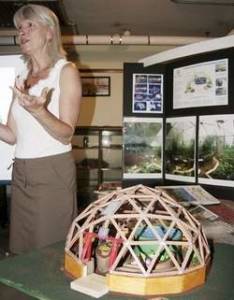
FARMINGTON, NM — Farmington New Mexico Gardeners’ Round-table received a talk, last week, on greenhouses that allow year-round cultivation, but yet require no electricity, nor propane, nor kerosene to keep temperatures above freezing in the depths of winter.
The big secret is a water tank that provides “thermal mass” and moderates the extremes of heat and cold. When the water tank is combined with a solar powered heating and ventilation system, along with multiple layered polycarbonate glazing and strategically placed insulation, the result is a pleasant, cheery haven for plants, vegetables and human beings, when snow is swirling outside.
Extolling the virtues of the Growing Domes — for these greenhouses, which are shipped out from Colorado in kit form, are all dome-shaped — were Joann and Rick Vollmer of Wise Way Wellness Center in Thornton, just north of Plymouth.
During their hour-long presentation, they described how they had progressed from having a regular hoop house, heated with kerosene on frosty spring nights, to buying a 33-foot diameter Dome, and told of their experiences since they erected it about five years ago.
“Six years ago, on a trip through Colorado, we saw our first Geodesic Dome. It was the 42′ (diameter) version, and we dreamed about it for a year. It is a big investment,” said Joann Vollmer.
Indeed, partly because of the 5-ply polycarbonate glazing, that slots into the dozens of interconnected triangles that comprise the dome, the price tags on these greenhouses may inflict gardeners with sticker shock.
Carl Ferland of Farmington, who currently has a hoop house for vegetables, said that the capability of year-round growing without fuel costs could prove profitable as the capital investment is gradually recouped.
“But not at our stage of the game,” he chuckled, referring to the fact that he and his wife Kay were well up in years.
The prices range, with the premium glazing recommended for northern climes factored in, from almost $5,690 plus shipping for a 12-foot diameter dome to over $41,000 for a community-sized 51-foot diameter. There are six other sizes in between, and the 22-footer, in the middle range, encompassing about 350 square feet, and reaching almost 11 feet at its apex, costs $11,150 plus shipping.
These prices, explained Rick Vollmer, include the cost of some bulky items that have to be obtained locally by the owner, in order to save on shipping costs — sheet metal and lumber for the water tank (a liner for which comes in the shipped kit), undersoil heating ducts, wall insulation, gravel for the perimeter base, and the like. Templates to build and instructions to install these items come in the kit.
The gardeners were interested in ventilation.
“Fans run off solar panels,” said Rick Vollmer, adding that the vents and shutters open automatically when the temperature rises inside the greenhouse, and paraffin wax in pistons melts, causing them to extend. The shutters are spring-loaded and close by themselves when the temperature drops and the paraffin in the pistons contracts.
Just like a sun room attached to a house, but of more practical use to a gardener, and with no heating costs, the geodesic dome greenhouses are places of comfort on winter days, especially if it is cloudless.
“”It is a great place to sit. With the snow outside, on a sunny day, it will be in the 70s inside,” said Joann Vollmer.
Temperatures in 70s sounded great to the audience, but for another reason. Even though the Vollmers were giving their talk at 6 p.m., Farmington was in the middle of a heat wave last week, and people were still enduring oppressive temperatures in the 90s even at that hour.
The average winter temperature in geodesic domes in northern climes, relying primarily on thermal mass and the polycarbonate glazing, is not sufficient to grow summer crops. In the fall, the Vollmers will plant the seeds for lettuce, arugula, swiss chard and the like. The plants have to be up by November because in December and January, depending on the climate of that year, they will hold their own, but not grow much more. The Vollmers pinch the leaves of the crop and harvest enough greens to get by.
“Then, in the third week of January, something seems to change. The light increases, the lettuce takes off again, and we have excess, which we sell in half pound bags or trade for things like eggs,” said Joann Vollmer.
Then, in February and March, they get a flying start on veggies like peppers and cucumbers, the latter being grown over an arbor. The Vollmers still maintain an outside garden for the space-consuming crops of summer— things like potatoes, zucchini and pumpkins.
On Saturday, Oct. 2, from 10 a.m. to 4 p.m., in conjunction with National Solar Day, the Vollmers, who are official distributors for the Growing Domes, are having an open house. The public is welcome to come and view their geodesic greenhouse for themselves.
